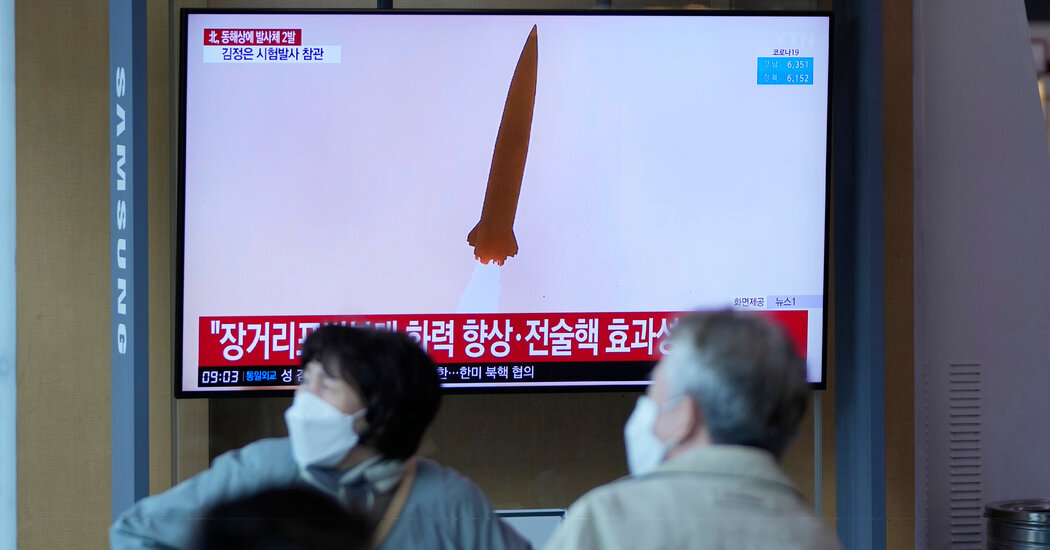SEOUL — North Korea has carried out its 12th missile test of the year, launching what appeared to be a pair of short-range projectiles off its east coast, South Korea’s military said on Sunday.
The two missiles were fired from Hamhung, a city on the North’s east coast, at 6 p.m. Saturday, the military said. They flew 68 miles, it said.
Earlier Sunday, the North Korean state media said that Kim Jong-un, the country’s leader, had supervised the launching of a “new-type tactical guided weapon,” giving no date or location for the test. It said the test would help the North improve its “efficiency in the operation of tactical nukes.”
Though the missiles seemed to be considerably less powerful than others the North has recently tested, the launch Saturday came at a moment of relatively high tension.
Friday was an important state holiday in North Korea, and the United States had sent an aircraft carrier to the region days earlier amid concern that Mr. Kim might mark the occasion with a major weapon test, perhaps even one involving a nuclear device.
North Korea’s First ICBM Firing Since 2017
On March 24, North Korea launched its first intercontinental ballistic missile since 2017, marking the end of a self-imposed moratorium.
Also, the United States and South Korea are set to begin annual joint military exercises on Monday. The drills consist largely of computer simulations and are said to be defensive in nature. But North Korea has condemned all of the two allies’ joint exercises as rehearsals for invasion and has often responded to them with weapon tests.
During former President Donald J. Trump’s administration, when the American leader and Mr. Kim were engaged in direct talks, the United States and South Korea began canceling or scaling back some of their joint military drills in hopes of adding momentum to the diplomatic efforts. But South Korea’s president-elect, Yoon Suk-yeol, who takes office next month, has vowed to expand the drills, saying they are needed to help deter North Korea’s growing nuclear and missile threats.
It was not immediately clear what type of missile the North had tested on Saturday. In the past, it has used the “new-type guided tactical weapon” language to refer to the short-range ballistic missiles known as KN-23 or KN-24. Those are among a variety of missiles North Korea has been testing since 2019 to improve its ability to fire short-range conventional or nuclear warheads at South Korea, Japan and the American military bases in the region.
In photos released by the North Korean state media on Sunday, the missile said to have been fired on Saturday resembled the KN-23.
The launch came days after the American aircraft carrier U.S.S. Abraham Lincoln had arrived in the waters between the Korean Peninsula and Japan. No specific reason was given for the deployment, but the carrier group was sent there amid concern that Mr. Kim might order a nuclear or intercontinental ballistic missile test around Friday — the 110th anniversary of the birth of North Korea’s founding leader, Kim Il-sung, Mr. Kim’s grandfather.
The Significance of North Korea’s Missile Tests
Instead, the holiday, North Korea’s biggest, was celebrated with large rallies, fireworks and cultural performances, but without a weapon test or a military parade.
Analysts have warned that more weapon tests are sure to come. North Korea has carried out an unusually high number of missile tests this year. The most recent, on March 24, was of the most powerful intercontinental ballistic missile it has yet launched, ending a yearslong, self-imposed moratorium on such tests.
Mr. Kim has vowed to double down on his nuclear and missile development programs since 2019, when his direct engagement with Mr. Trump ended with no agreement on rolling back his nuclear weapon program or lifting the international sanctions imposed on the North in response to it.
Check out our Latest News and Follow us at Facebook
Original Source
